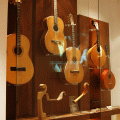This is the museum not to be missed if you want to find out more about fado, and Lisbon fado in particular.
This is the museum not to be missed if you want to find out more about fado, and more specifically about Lisbon fado, recognized in 2011 as an Intangible Cultural Heritage of Humanity by UNESCO. The permanent exhibition's well-designed itinerary allows you to discover the history of fado, its origins in19th-century Lisbon, its spread through revue theater, radio, recordings and cinema, as well as the technical evolution of its instrument: the guitar. Educational too, with its musical and multimedia terminals. And let's not forget the superb and spellbinding O Fado (1910) by the brilliant painter José Malhoa (1855-1933), the image par excellence of the musical style, declared a World Heritage Site by UNESCO at the end of 2011. The museum bookshop is also well-stocked with books (in all languages!) and records of fado "extended" to... Leonard Cohen, for example! The visit can be rounded off with a fetish pilgrimage to the house-museum of the great Amália Rodrigues, who was the idol of an entire people. Fado concerts are held there regularly. A true tribute to fado and its two instruments: the viola (the classic Spanish guitar), which sets the cadence and tone, and the guitarra portuguesa, a kind of twin 6-string mandolin used for arpeggios and accompaniment.
Did you know? This review was written by our professional authors.
Members' reviews on MUSEU DO FADO (FADO MUSEUM)
The ratings and reviews below reflect the subjective opinions of members and not the opinion of The Little Witty.
















Je ne connaissais pas le fado. Le musée à comblé cette lacune. Avec un audio guide en français, on nous explique l histoire du fado avec quelques peintures, documents et instruments. Mais chose vraiment bien, il y a un point pour écouter dès disques de fado. Il est donc petit mais bien fichu. À voir!